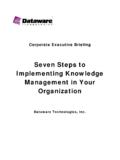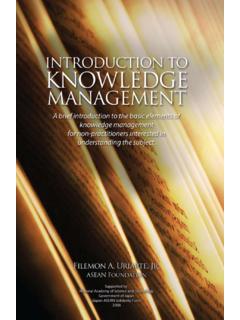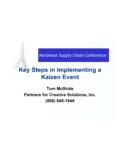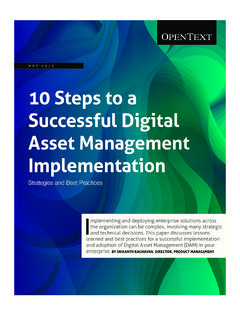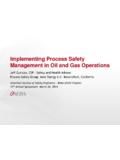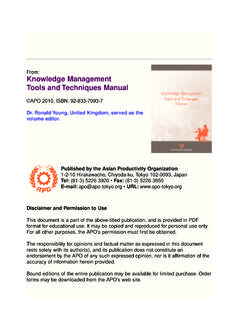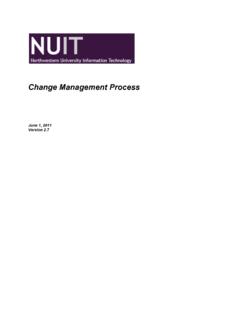Transcription of BY ORDER OF THE AIR FORCE INSTRUCTION 33-396 …
1 BY ORDER OF THE SECRETARY OF THE AIR FORCE AIR FORCE INSTRUCTION 33-396 7 NOVEMBER 2014 Communications and information knowledge management COMPLIANCE WITH THIS PUBLICATION IS MANDATORY ACCESSIBILITY: Publications and forms are available on the e-publishing website at for downloading and ordering. RELEASABILITY: There are no releasability restrictions on this publication. OPR: SAF/CIO A6SF Certified by: SAF/CIO A6S (Brig Gen Sarah E. Zabel) Pages: 26 This publication implements Air FORCE Policy Directive (AFPD) 33-3, information management ; defines knowledge management (KM) and provides objectives for all organizations to effectively and efficiently accomplish the lifecycle of information ; supports mission and business processes; establishes roles and responsibilities to carry out those objectives; defines the specific function and duties of the 3D0X1 ( knowledge management ) Air FORCE Specialty Code (AFSC); determines how each AF organization will be provided KM support; and provides essential KM resources to assist with improving the information lifecycle.
2 This INSTRUCTION applies to all Air FORCE personnel to include active duty, guard, and reserve military, civilian, foreign nationals employed by the Department of the Air FORCE and Air FORCE contractor personnel. Contractors who perform KM functions, as defined in this INSTRUCTION , must fully comply with the duties for their assigned role. Performance work statements for contracts awarded to perform any of the KM roles in this INSTRUCTION will reflect this requirement. This AFI may be supplemented at any level, but all supplements that directly implement this publication must be routed to SAF/A6S Policy and Strategy Division for coordination prior to certification and approval. Refer recommended changes and questions about this publication to the Office of Primary Responsibility (OPR) using the AF Form 847, Recommendation for Change of Publication; route AF Forms 847 from the field through the appropriate functional chain of command.
3 The authorities to waive wing/unit level requirements in this publication are identified with a Tier ( T-0, T-1, T-2, T-3 ) number following the compliance statement. See AFI 33-360, Publications and Forms management , Table for a description of the authorities associated with the Tier numbers. Submit requests for waivers through the chain of command to the appropriate Tier waiver approval authority, or alternately, to the Publication OPR for non-tiered compliance items. Ensure that all records created as a result of processes prescribed in this publication are maintained in accordance with (IAW) Air FORCE Manual (AFMAN) 33-363, 2 AFI33-396 7 NOVEMBER 2014 management of Records, and disposed of IAW Air FORCE Records information management System (AFRIMS) Records Disposition Schedule (RDS). The use of the name or mark of any specific manufacturer, commercial product, commodity, or service in this publication does not imply endorsement by the Air FORCE .
4 Chapter 1 OVERVIEW 4 Introduction.. 4 Terminology.. 4 Figure KM Context Model.. 5 Capabilities.. 5 Technology.. 6 Processes.. 6 People.. 6 Chapter 2 knowledge management EFFECTS, CAPABILITIES, AND STANDARDS 8 Effects.. 8 Capabilities.. 8 Standards.. 10 Chapter 3 knowledge management ROLES AND RESPONSIBILITIES 12 The Office of the Secretary of the Air FORCE Chief information Officer (CIO) and Chief, information Dominance.. 12 Air FORCE Space Command (AFSPC).. 12 Air FORCE knowledge management Working Group (AFKMWG).. 13 Commanders and Directors.. 14 knowledge management Centers (KMC).. 14 All AF Employees.. 14 Chapter 4 THE knowledge management CENTER (KMC) 15 Overview.. 15 KMC Roles and Capabilities.. 15 Support for Tenant Organizations.. 18 Support for Geographically Separated Units (GSUs) and Mission Separated Units (MSUs).
5 18 KMC Organization Structure.. 18 Military AFSC 3D0X1.. 19 AFI33-396 7 NOVEMBER 2014 3 Chapter 5 knowledge management IN SUPPORT OF CONTINGENCY OPERATIONS 20 General.. 20 Operational knowledge management .. 20 Command and Control (C2) Enterprise.. 20 Expeditionary KM Support.. 20 Chapter 6 knowledge management TRAINING AND OTHER RESOURCES 22 General.. 22 Career Field Training.. 22 5-Level and 7-Skill Level Training Tracks.. 22 Optional Training.. 22 User Training.. 22 KM Collaboration.. 22 Attachment 1 GLOSSARY OF REFERENCES AND SUPPORTING information 23 4 AFI33-396 7 NOVEMBER 2014 Chapter 1 OVERVIEW Introduction. Timely, accurate, and relevant information is imperative for planning and conducting air, space, and cyberspace operations within the Air FORCE . A lack of decision-ready, actionable knowledge degrades our ability to conduct and support operations with the certainty required to support national military objectives.
6 Turning raw data into information that enables the creation and transfer of knowledge requires an approach of careful collaboration, analysis, deliberation, and judgment. knowledge management (KM) supports this approach by using a combination of technology, processes and people to achieve mission superiority. Terminology. knowledge is information being placed in context (human transformation) based on facts and an ascribed meaning (human experience, etc.) Air FORCE members transfer this knowledge , which is collected from subject matter experts (SME), to others by documenting best practices to create enduring explicit knowledge . AFPD 33-3 defines knowledge as - information from multiple domains that has been synthesized, through inference or deduction, into meaning or understanding.
7 It comes in two forms: explicit and tacit. Explicit knowledge consists of written or otherwise documented knowledge in media that can be organized or stored, whether in digital form or other. It is definite, openly stated, and often objective. Explicit knowledge lends itself to rules, limits, and precise meanings. It is easily collected, stored, and disseminated using information systems. Examples of explicit knowledge include field manuals, unit operating procedures, operation orders, and technical specifications. During operations, this knowledge is created and applied to support understanding and decision-making. Tacit knowledge is comprehension gained through study, experience, and practice. Air FORCE members transfer this transient knowledge to others by documenting best practices and create enduring explicit knowledge .
8 KM involves the capturing, organizing, and storing of knowledge and experiences of individual workers and groups within an organization and making this information available to others within the organization. KM is defined as the integration of people and processes, enabled by technology, to facilitate the exchange of operationally relevant information and expertise to increase organizational performance. This involves creating, organizing, applying, and transferring knowledge to facilitate situational understanding and decision-making, which enables decision superiority. KM relies on solid information management . information management (IM) is the science of using procedures and information systems to collect, process, encode with metadata, store, retrieve, display, disseminate, and protect knowledge products, data, and information .
9 Through effective IM, KM ensures all mission processes have access to relevant cross-functional information in a collaborative, timely, and contextual manner. Figure provides the context for understanding KM. Data are the elements that may be combined into information . information is the message that resolves uncertainty for the AFI33-396 7 NOVEMBER 2014 5 receiver. knowledge results from information being placed in context (human transformation) based on facts and an ascribed meaning ( , human experience). KM also uses workflow reviews and assessments to reveal best practices and opportunities for improvement. This leads to the development of new or revised processes which, in turn, optimize workflow and create scalable efficiencies. information from enterprise systems are integrated with opinions, analysis, and predictions from subject matter experts (SME) through collaboration to provide actionable knowledge to improve operating efficiency and optimize mission effectiveness.
10 Some examples of the KM products include courses of action (COA), FORCE movement and sustainment plans, search and rescue plans, and decision-aiding presentations. Figure KM Context Model. Capabilities. KM provides warfighters with the capability to rapidly access and exploit authoritative, accurate, and relevant information to plan COAs and execute missions. This specifically includes virtual collaboration, tailored information presentation, integrated data and information , locating and accessing relevant information , sharing information and knowledge , managing information , and intelligence information architecture. This enables sharing of information and knowledge among communities of interest (COI), communities of practice (COP) and coalition partners in a common, collaborative information environment, 6 AFI33-396 7 NOVEMBER 2014 supporting network services, improved search engine technologies, and integration of knowledge managers and training.










